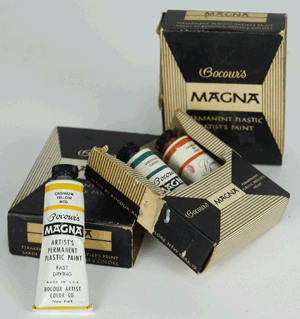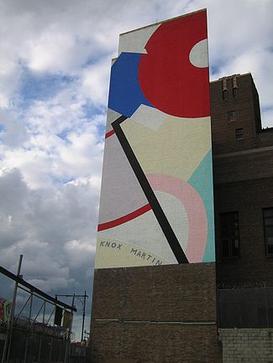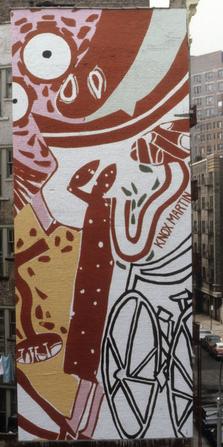
Acrylic paint is a fast-drying paint made of pigment suspended in acrylic polymer emulsion and plasticizers, silicone oils, defoamers, stabilizers, or metal soaps. Most acrylic paints are water-based, but become water-resistant when dry. Depending on how much the paint is diluted with water, or modified with acrylic gels, mediums, or pastes, the finished acrylic painting can resemble a watercolor, a gouache, or an oil painting, or have its own unique characteristics not attainable with other media.

Oil painting is the process of painting with pigments with a medium of drying oil as the binder. It has been the most common technique for artistic painting on wood panel or canvas for several centuries, spreading from Europe to the rest of the world. The advantages of oil for painting images include "greater flexibility, richer and denser colour, the use of layers, and a wider range from light to dark". But the process is slower, especially when one layer of paint needs to be allowed to dry before another is applied.

Magna is the brand name of an acrylic resin paint, developed by Leonard Bocour and sold by Bocour Artist Colors, Inc. in 1947. It is somewhat different from modern acrylic paint, as it is composed of pigments ground in an acrylic resin brought into emulsion through the use of solvents. Magna paint has more of a shine to it than most modern acrylic paint, a glossier finish. In 1960, Bocour Artist Colors developed a water-borne acrylic paint named Aqua-Tec. Modern acrylic paint is water-soluble, while Magna is miscible with turpentine or mineral spirits, though both can dry rapidly to a matte or glossy finish. It was used by artists such as Barnett Newman, Morris Louis, and Roy Lichtenstein. Roy Lichtenstein used magna with oil paints.
Leonard Bocour was an American artist.

Oil paint is a type of slow-drying paint that consists of particles of pigment suspended in a drying oil, commonly linseed oil. The viscosity of the paint may be modified by the addition of a solvent such as turpentine or white spirit, and varnish may be added to increase the glossiness of the dried oil paint film. The addition of oil or alkyd medium can also be used to modify the viscosity and drying time of oil paint. Oil paints were first used in Asia as early as the 7th century AD and can be seen in examples of Buddhist paintings in Afghanistan. Oil-based paints made their way to Europe by the 12th century and were used for simple decoration, but oil painting did not begin to be adopted as an artistic medium there until the early 15th century. Common modern applications of oil paint are in finishing and protection of wood in buildings and exposed metal structures such as ships and bridges. Its hard-wearing properties and luminous colors make it desirable for both interior and exterior use on wood and metal. Due to its slow-drying properties, it has recently been used in paint-on-glass animation. The thickness of the coat has considerable bearing on the time required for drying: thin coats of oil paint dry relatively quickly.
Morris Louis Bernstein, known professionally as Morris Louis, was an American painter. During the 1950s he became one of the earliest exponents of Color Field painting. While living in Washington, D.C., Louis, along with Kenneth Noland and other Washington painters, formed an art movement that is known today as the Washington Color School.

Color field painting is a style of abstract painting that emerged in New York City during the 1940s and 1950s. It was inspired by European modernism and closely related to abstract expressionism, while many of its notable early proponents were among the pioneering abstract expressionists. Color field is characterized primarily by large fields of flat, solid color spread across or stained into the canvas creating areas of unbroken surface and a flat picture plane. The movement places less emphasis on gesture, brushstrokes and action in favor of an overall consistency of form and process. In color field painting "color is freed from objective context and becomes the subject in itself."
Water-miscible oil paint is oil paint either engineered or to which an emulsifier has been added, allowing it to be thinned and cleaned up with water. These paints make it possible to avoid using, or at least reduce volatile organic compounds such as turpentine that may be harmful if inhaled. Water-miscible oil paint can be mixed and applied using the same techniques as traditional oil-based paint, but while still wet it can be removed from brushes, palettes, and rags with ordinary soap and water. One of the ways its water solubility comes from is the use of an oil medium in which one end of the molecule has been engineered to be hydrophilic and thus bind loosely to water molecules, as in a solution. This type of paint is different to those that are engineered to enable cleaning of brushes and application equipment in water but are not in themselves water reducible.

Aerosol paint is paint that comes in a sealed, pressurized container and is released in an aerosol spray when a valve button is depressed. Aerosol painting is one form of spray painting; it leaves a smooth, even coat, unlike many traditional rolled and brushed paints. Standard-sized cans are lightweight, portable, inexpensive, and easy to store. Aerosol primer can be applied directly to bare metal and many plastics.
Sennelier is a French manufacturing company of art materials, mostly famous for its hand selected pigments. The company produces a wide range of paint products, including acrylic, oil, watercolor, gouache, oil and soft pastel, india ink, tempera, and other media.

Liquitex is a US company that supplies art materials, focusing exclusively on the development, manufacture and distribution of acrylic paints. Founded by Henry Levison as "Permanent Pigments" in 1955, the company created the first water-based acrylic gesso. That same year, Levison decided to reorganize the company under the name "Liquitex". In 1956, the company starting selling water-based "Soft Body" acrylic paints. In 1963, "Heavy Body" paints were available with a thicker consistency. The company offers the largest number of acrylic paint products in the world.
Grumbacher is a US brand of art materials. Grumbacher offers products for artists including acrylic paints, oil paints, watercolor paints and other painting media, as well as brushes.
Sam Golden started his paintmaking career in 1936 at Bocour Artist Colors with his uncle Leonard Bocour. In 1947, he developed Magna paint, the world's first artist acrylic paint. He returned from retirement in 1980 to found Golden Artist Colors Inc. based in New Berlin, New York, with his son Mark Golden.

Venus is a twelve-story-high mural painting by Knox Martin on the south side of Bayview Correctional Facility at 19th Street and Eleventh Avenue in Manhattan, New York City.

Knox Martin was an American painter, sculptor, and muralist.
Nova Color Artists Acrylic Paint was first manufactured in Culver City, California in 1965 shortly after the commercial introduction of acrylic polymer resin for paint production. Mexican immigrant Carlos Amparan developed a line of brilliantly colored fine art acrylic paint after experimenting with this relatively new water-borne emulsion. He and his brother Raoul began small-scale production of Nova Color and sold it at a low price to local artists.

Woman with Bicycle is a six-story wall painting created by the American painter, sculptor and muralist Knox Martin in 1979 under the sponsorship of the Public Art Fund.
Alden Carlson Mason was an American painter from Washington known for creating abstract and figurative artwork. Mason was a professor of art at the University of Washington for over 30 years. His painting are held in a number of public collections including the San Francisco Museum of Modern Art, the Seattle Art Museum, the Portland Art Museum, and the Milwaukee Art Museum.

Utrecht Art Supplies is an art materials manufacturing and chain store company, based in Brooklyn. Utrecht, founded in 1949 in New York City by artist Norman Gulamerian and his brother Harold Gulamerian, sells a large range of art material brands including its own line of products. Art materials produced by Utrecht include acrylics, watercolor, oils, brushes

Old Holland is a company based in the Netherlands, that manufactures high-quality painting supplies. Founded in 1664, the company continues the heritage of Old Dutch Masters, making products that include: oil paint, watercolor paint, acrylic paint, auxiliaries, and pigments.











